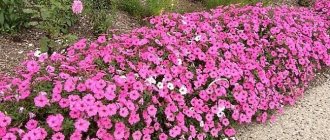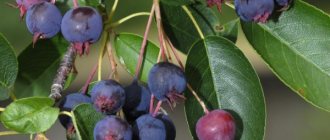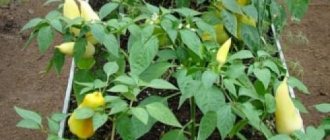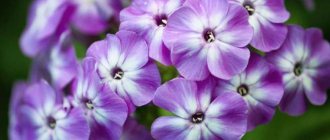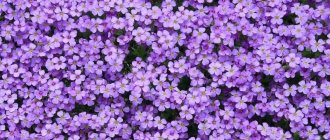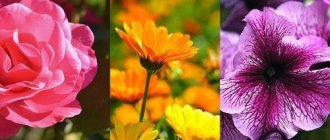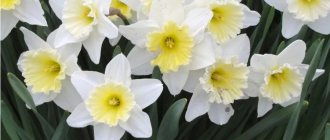Batun
This cold-resistant onion tolerates drought well and can grow in one place for up to 6 years. In spring it grows quickly and supplies gardeners with lush greens. It is cut in dry weather when the leaves reach a length of 20-25 cm.
It is better to give preference to varieties with a late flowering period - Gulden, Damast, Zelenets, Izumrudny, Kaigaro, Katana, Ladozhsky, Trinity, Pierrot.
| Sowing depth | Sowing/planting scheme | Better predecessors | Good neighbors | Unwanted neighbors | Top dressing (per 1 sq.m.) |
| 2 cm – on heavy soils, 3 cm – on light soils | 9-10×25-30 cm | Lettuce, Chinese cabbage, dill | Kohlrabi, broccoli, Brussels sprouts, beets, carrots, tomato, eggplant, lettuce, chicory, leek, garlic, strawberries, tobacco, cucumber, calendula, savory | Radish, radish, beans, peas, sage, white cabbage | In spring and autumn, add 1 tbsp. ammonium nitrate and superphosphate, 0.5 tbsp. potassium sulfate |
Katran
This culture is often called Oriental and Tatar horseradish. Its thick, fleshy and long roots are indeed similar to horseradish, but they have a less bitter taste. In the fall, katran leaves and roots are used for pickling and pickling; in the spring, young shoots with leaves are also eaten: they are boiled or chopped fresh into salads.
Katran tolerates drought and cold well. The plant reproduces by rhizomes and seeds (they are very large - about 1 cm in diameter). Seeds are sown before winter (in September-October) in neutral, nutritious soil. First add half a bucket of rotted compost and 1 cup of slaked lime per 1 sq.m.
Recommended varieties of katran for growing in the middle zone: Accord, Picadrome.
| Sowing depth | Sowing/planting scheme | The best predecessors | Good neighbors | Unwanted neighbors | Top dressing (per 1 sq.m.) |
| 3-3.5 cm | 40×60 cm | Potatoes, tomato, cucumber | Potatoes, aromatic herbs | Strawberries, tomatoes, beans | In spring and autumn, add 1-1.5 tbsp. ammonium nitrate and potassium sulfate per 10 liters of water, 2 tbsp. superphosphate (in granules) |
Use in landscape design
Plants are often used in landscape design. When properly created, flower beds can form intricate patterns.
Iberis look great in the structure of ridges and mixborders. They can be used to decorate the edges of borders. Group plantings of flowers are used to decorate garden paths.
The flower goes well with evergreens, such as juniper or cypress. Low-growing varieties can be used to decorate rock gardens and rocky hills.
Dwarf crops harmonize well with drought-resistant ground covers. These include creeping phlox, creeping tenacious, sedum. Delicate Iberis flowers can be combined with large bells.
Iberis is often combined with gazania, yarrow and small marigolds. A spectacular composition is obtained with the participation of phlox and tulips. However, flowers should not be combined with ground cover perennials.
The culture fits perfectly into garden compositions
When growing Iberis plants, planting and care must be carried out according to all the rules. This culture is considered quite unpretentious, but in order to achieve abundant flowering, you need to follow certain recommendations.
Multi-tiered bow
This plant looks very original thanks to its aerial bulbs (bulbs), which are arranged in several tiers. In the garden, bulblets are planted in spring or autumn, but at home on the windowsill they can be grown all year round.
The best varieties of multi-tiered onions: Likova, Pamyat, Chelyabinsk.
- Multi-tiered onions: features of planting, care and propagation
Learn all about this unusual type of onion.
| Sowing depth | Sowing/planting scheme | The best predecessors | Good neighbors | Unwanted neighbors | Top dressing (per 1 sq.m.) |
| 10 cm – for root bulbs, 6-8 cm – for bulbs | 3-4×25-30 cm | Peas, beans, beans | Kohlrabi, broccoli, Brussels sprouts, beets, carrots, tomato, eggplant, lettuce, chicory, leek, garlic, strawberries, tobacco, cucumber, calendula, savory | Radish, radish, beans, peas, sage, white cabbage | In spring and autumn, add 2 tbsp. superphosphate, 1 tbsp. ammonium nitrate and potassium sulfate |
Curly
Climbing perennial plants are planted next to the support. They decorate gazebos, arches, terraces, and walls of houses.
Wisteria is a heat-loving perennial plant that forms cascades of lilac clusters. During the cold season, you need to move the flower indoors.
Most types of clematis do not tolerate cold, but there are also varieties suitable for growing in Siberia. You can grow it not in the ground, but in special containers, then it will be easy to move clematis indoors for the winter.

Climbing roses are very beautiful, but thorny. For the winter they need to be removed and covered.
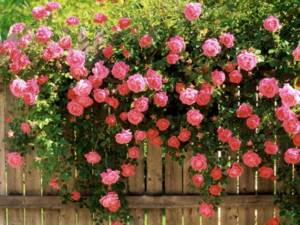
Honeysuckle is cold-resistant and unpretentious; it needs to be pruned every year to maintain its shape.

Actinidia is also unpretentious, in addition, its fruits have medicinal properties. Requires regular watering.
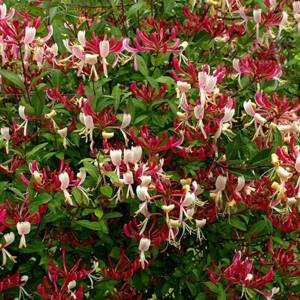
Maiden grape has small white flowers, but grows well and is suitable for arbors and where shade is required.
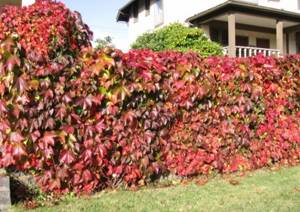
Mint
Each type of mint has its own beneficial properties. Therefore, if the territory allows, try to grow several crops: peppermint (varieties Azhurnaya, Bergamotnaya, Vesna, Medichka), water mint, field mint (In Memory of Kirichenko), chocolate mint, catmint (Basilio, Velvet), garden mint. Most often, peppermint is grown in summer cottages.
Mint propagates by roots, cuttings and seeds. It is recommended to have a separate fenced garden bed for this aromatic plant, since its powerful root system can spread throughout the area and crowd out vegetable crops.
| Sowing depth | Sowing/planting scheme | Best Predecessors | Good neighbors | Unwanted neighbors | Top dressing (per 1 sq.m.) |
| 0.5 cm | 25×45 cm | Tomato, legumes, melon, any root vegetables | All types of cabbage, potatoes | – | In spring, add 1 tbsp. ammonium nitrate, superphosphate, potassium salt per 10 liters of water |
Rhubarb
Rhubarb stems have a delicate, sour taste. They are used to make jelly, compotes, jam, and pie filling. The color of the petioles can be red or green, depending on the variety.
The best varieties of rhubarb: Altai Zori, Beauty, Victoria, Zaryanka, Malachite, Stubborn, Candied.
Rhubarb reproduces well by seeds and grows in one place for about 10 years. But for proper development, the plant must be provided with fertile, loose and sufficiently moist soil.
The seeds are soaked in damp gauze and sown in the furrows after sprouts appear. When a pair of true leaves appear on the sprouts, the crops are thinned out so that the distance between the seedlings is at least 20 cm.
| Sowing depth | Sowing/planting scheme | The best predecessors | Good neighbors | Unwanted neighbors | Top dressing (per 1 sq.m.) |
| 2-3 cm | 20-25×30-35 cm | Lettuce, radishes, different types of onions | Perennial onions, horseradish, peas, cabbage, radishes, lettuce, celery, beans, spinach | Gooseberry | In spring and autumn, add 1 tbsp. ammonium nitrate and potassium sulfate and 2 tbsp. superphosphate |
Slime
This onion has flat, smooth and succulent leaves with rounded ends. The plant contains a lot of iron, so it is useful for anemia. The slime onion can grow in one place for 6-8 years, it is unpretentious, it goes under the snow along with the leaves, and in early spring after the snow melts it again supplies gardeners with useful herbs.
Recommended varieties of slime onions: Waltz, Dwarf, Fount of Health, Leader, Green, Charm, Salad, Simbir.
| Sowing depth | Sowing/planting scheme | The best predecessors | Good neighbors | Unwanted neighbors | Top dressing (per 1 sq.m.) |
| 1.5 cm | 14×40 cm | Cabbage, tomato, cucumber, radish, potato | Kohlrabi, broccoli, Brussels sprouts, beets, carrots, tomato, eggplant, lettuce, chicory, leek, garlic, strawberries, tobacco, cucumber, calendula, savory | Radish, radish, beans, peas, sage, white cabbage | In spring, add 1 tbsp. urea and special fertilizer for onions and garlic |
Jerusalem artichoke
Jerusalem artichoke flowers, similar to small sunflowers, will be an excellent decoration for the garden bed, and its tubers (the so-called earthen pears), due to their high content of nutrients, will help cope with almost all ailments.
In the middle zone, Jerusalem artichoke is propagated by tubers. They are planted in rows at the end of April - beginning of May or in the fall. The plant is not picky about the type of soil, but it is important that it is non-acidic. The culture is unpretentious and drought-resistant, requiring watering only in dry summers.
The best varieties of Jerusalem artichoke: Interest, Omsky white, Skorospelka, Solnechny, Pasko.
| Planting depth | Sowing/planting scheme | The best predecessors | Good neighbors | Unwanted neighbors | Top dressing (per 1 sq.m.) |
| 12-15 cm | 45×65 or 60×60 cm | Potatoes, cabbage, cucumber | Corn, potatoes, raspberries, currants | Carrots, sunflowers | In spring, add 2 tbsp. Fertiki Universal; water with mullein every 2-3 years (1:15) |
Perennial grasses under cover that has not yet been mowed
Annual grasses should be removed approximately 60 days after emergence to lighten the perennials and not interfere with their intensive development. If the cover is removed early and the weather is favorable, the forage grass crops will grow quickly. Overgrown grasses must be mowed at the level of the remaining cover (stubble) no later than 30 days before their growth and development ceases. This should be done around the end of August to mid-September.
View of the field after harvesting the cover crop
If the deadlines are missed, the herbs will have to be harvested in the third ten days of October, after the cessation of seasonal development and growth. Moreover, if you get to work earlier, at the end of September or beginning of October, the grass will use up reserve nutrients for regrowth, but will not have time to accumulate them for a successful wintering. Mowing down perennials means ensuring a good wintering, avoiding damping off of the plants, and reducing the likelihood of disease.
Our first experience turned out to be difficult, although in terms of manufacturability we worked well. The weather was not good, there were not enough people and equipment, and the time of harvesting the cover crop coincided with the time of intensive hay harvesting. Therefore, the cover grasses were not removed in a timely manner, but in order to properly grow perennial grasses, it is worth listening to the instructions stated above. We still hope for the planned result - to get a powerful grass stand from the sown perennials next year.
Perennial grass growing after mowing
Thus, it is not necessary to buy hay at exorbitant prices every year. If simple instructions are followed, a small farm can grow perennial grasses for hay.

Field two weeks after harvesting the cover crop
Field three weeks after cover crop harvested
View of the field at the end of October 2021
This is how the grass goes into winter
View of the field in early May 2021
Horseradish
Horseradish grows well without any care and can live in one place for up to 10 years, but to obtain more succulent roots, the plant needs to be provided with acidified and moist soil.
Horseradish is propagated by root cuttings with a diameter of 0.7-1.5 cm and a length of 20-25 cm. They are planted in spring or autumn, and buried obliquely at an angle of 45 degrees, so that there is a layer of earth 4-5 cm thick above the top point.
Horseradish varieties recommended for cultivation: Atlant, Valkovsky.
| Planting depth | Planting scheme | The best predecessors | Good neighbors | Unwanted neighbors | Top dressing (per 1 sq.m.) |
| 4 cm of soil above the spine | 30-40×60-70 cm | Potatoes, tomato, cucumber, beets, legumes | Potatoes, aromatic herbs | Strawberry, tomato, beans | In spring, add 1 tbsp. ammonium nitrate and potassium sulfate per 10 liters of water |
Rudbeckia triloba
This stunning yellow rudbeckia has smaller flowers than most other rudbeckias, but is an incredibly showy plant. Rudbeckia triloba is distinguished by a tall, stable stem and airy inflorescences consisting of many bright yellow daisies with an expressive black center.

Rudbeckia triloba has smaller flowers than other rudbeckias, but this plant is incredibly showy. Lyudmila Svetlitskaya
The most popular variety of this type of rudbeckia, Prairie Glow, has an even more attractive appearance. This cultivar is notable for its expressive dark red stems, but the flowers, which at the beginning of blooming have a yellowish-orange color, deserve special attention, and later, as they bloom, the rusty shades intensify. At the same time, lowering the temperature also makes the baskets brighter. Thus, on the plant you can observe inflorescences colored with different intensities, which creates a very picturesque effect.
The flowering of Rudbeckia triloba does not last long, but it is always welcome in the autumn mixborder and goes well with tall herbs (millet, miscanthus, molinia, reed grass).
Plant height is from 80 centimeters to 1.5 meters. For the greatest effect, it is better to plant several specimens in a clump, since its bushes are not too branchy and do not grow in width.
Rudbeckia is undemanding to growing conditions, but most of all it will like moisture-intensive, not too dry soil and sunny places. The plant does not require any additional fertilizing or special care or treatment against pests and diseases. Therefore, Rudbeckia triloba can be safely called another flower for the lazy.
Since rudbeckia does not repeat flowering, there is no need to cut off faded inflorescences. It is better to leave the rounded seed heads in the flower garden so that they give the mixborder additional structural expressiveness.
Thyme
Thyme (also known as thyme) is beautiful, aromatic, and healthy. Decoctions and infusions of dried thyme (by the way, the raw material is harvested in July-August) will perfectly help you save on medicines for colds and various diseases of internal organs. And tea with thyme will relieve depression and insomnia.
Thyme can grow in any soil; it can bloom in the shade, but feels better in bright sun. The main technique for growing this herb is mulching with compost (3-5 cm layer) in spring and autumn. You can even do without watering, since thyme tolerates drought well. But for the winter in the middle zone, it is recommended to cover the bushes to protect them from freezing.
The best varieties of thyme: Aibolit, Alexandrite, Fragrant bed, Snake, Limoncello, Honey aroma, Tibul.
| Planting depth | Sowing/planting scheme | The best predecessors | Good neighbors | Unwanted neighbors | Top dressing (per 1 sq.m.) |
| 5 cm (for seedlings), 0.5 cm (for seeds) | 20×35 cm | Cucumber, zucchini, peas, beans, beans | Eggplant, potatoes, tomato | – | Once every 2-3 years, add 1 tbsp. ammonium nitrate and 0.5 tbsp. superphosphate and potassium sulfate |
Perennial herbaceous plants
The garden has a large selection of perennial plants to decorate the garden; you can choose plants so that the garden is blooming from early spring to late autumn.
The garden collection includes both beautifully flowering perennials and decorative deciduous ones that have ornamental foliage and allow you to put the necessary accents in flower beds.
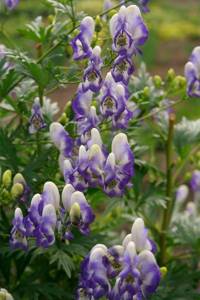
Wolfsbane, aconite , is a tuberous perennial plant.
Tubers that produce flowering shoots completely die off in the fall, along with the stems and roots. Daughter buds of renewal, developing at the very bottom of the one-year stem and having by this time formed their own autonomous roots and even basal rosettes of leaves, become isolated, forming a colony of young plants. The height of aconite is 70-100 cm, flowers are up to 4 cm long, irregular, with a large helm, purple.
The garden collection includes a garden form of aconite - two-color, violet and white. Blooms from July to September. Frost-resistant, poisonous, undemanding to soil, tolerates light shading.
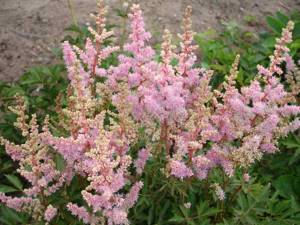
Small flowers are collected in graceful elongated paniculate inflorescences. The colors of the flowers are varied - white, cream, pink, red, lilac. Blooms in June-July. Prefers well-moistened, semi-shaded places. Propagated by dividing bushes in spring or late summer.



Brunner prefers loose, fertile soils. Shade-tolerant. Winter-hardy.
Propagated by sowing seeds and dividing rhizomes in the fall.
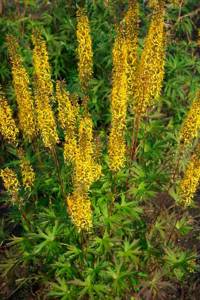
Buzulnik is light-loving, but also tolerates light partial shade, is winter-hardy, and grows well on any cultivated soil.
Buzulniks reproduce by sowing seeds and dividing rhizomes in the spring.
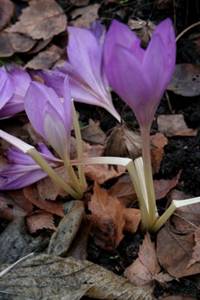
Colchicums bloom in autumn and bloom in a leafless state.
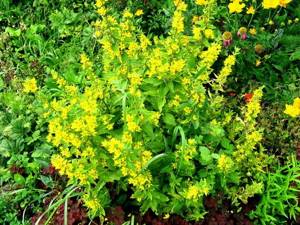
Moisture-loving, blooms from May to July.
Monetary loosestrife is very good as a ground cover plant.
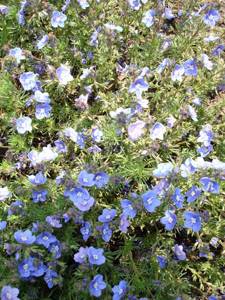
Planted in borders, mixborders. Low-growing species of speedwells are well suited for rocky gardens.
Speedwells are propagated by division, cuttings and sowing seeds.
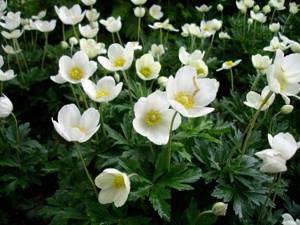
They prefer light, loose, fertile, well-drained and sufficiently moist soil. Anemone tolerates partial shade well and blooms in June.
Propagated by root suckers and seeds.

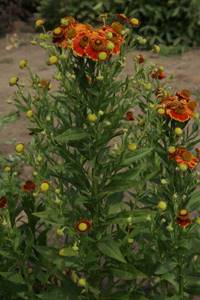
Thus, Helenium does not have a perennial rhizome, and the “bushes” are colonies of independent plants.
Young plantings of helenium are more winter-hardy; in old bushes, renewal buds are at ground level or higher and can freeze in winters with little snow, so it is better to cover old bushes with earth for the winter.
Autumn helenium blooms in the second half of summer, the color of the flowers ranges from golden yellow to bronze-red. Helenium propagates by sowing seeds, as well as by dividing bushes. Prefers light fertile soils, open sunny places.
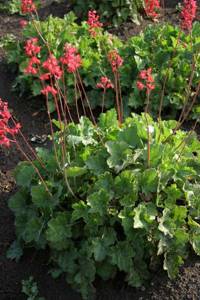
Heuchera is light-loving, but also tolerates partial shade, is cold-resistant, and prefers light, fertile soils.
Propagated by seeds, dividing the bush in early spring.
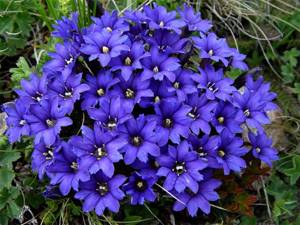
Gentian is winter-hardy, but requires shelter in winters with little snow. Propagated by dividing bushes and freshly collected seeds, which are sown before winter.
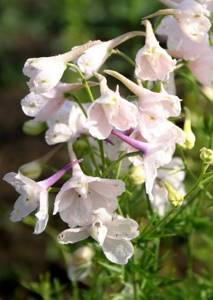
They reproduce by seeds, by dividing bushes, and it is better to divide bushes in the spring.
Delphinium inflorescences are very decorative and are often used for cutting.
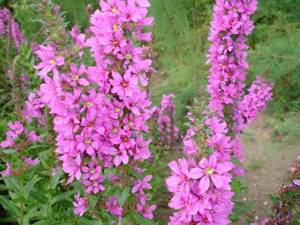
The flowers are lilac-pink, collected in long spike-shaped inflorescences.
Very good for planting near ponds. Winter-hardy, unpretentious.
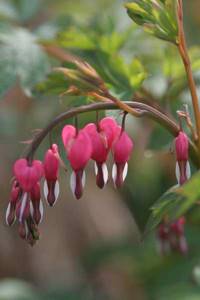
Prefers open or slightly shaded places, light, humus-rich soil. Propagated by dividing bushes and stem cuttings.
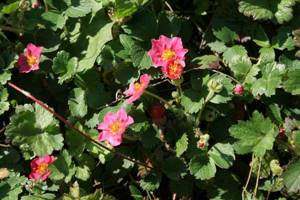
Dushenia is very unpretentious and winter-hardy. Duchenia is often used as a ground cover plant that replaces a lawn.
There are several types of irises in White Orchid.


Siberian iris propagates by dividing the bush, and the planting unit must have at least 2 leaf bunches.

Grows well both in the sun and in the shade, is frost-resistant, and tolerates excess moisture. The height of the bush is 1-1.5 meters.
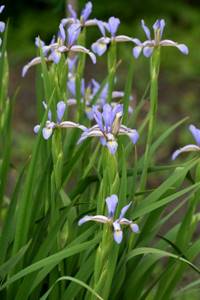
It blooms in June with graceful bluish flowers. Propagated by dividing the bush and seeds.
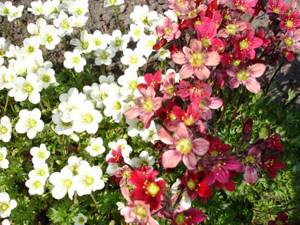
Grows well in moist, sandy or loamy soils.
Blooms in May-June.
Propagated by dividing bushes, individual rosettes and seeds.
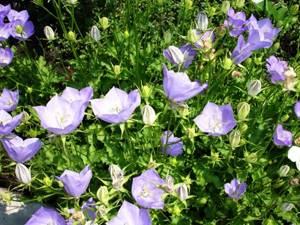
Flowering from June to September. Propagated by seeds or dividing the bush. Frost-resistant. Often self-seeding.
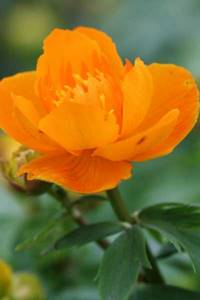
The swimsuit blooms in June-July. The plant is winter-hardy and moisture-loving. Optimal growing conditions are moist, loose, fertile soil. The swimsuit grows well in partial shade. Propagated by dividing bushes and sowing seeds.
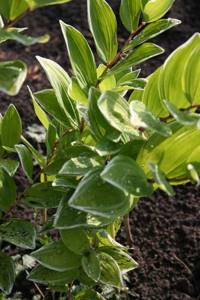
The plant is unpretentious, winter-hardy, grows well in partial shade. Propagated by dividing rhizomes.
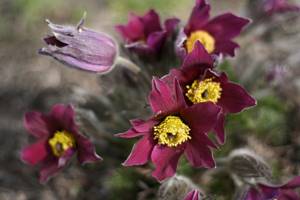
A lumbago - an open snowdrop, a dream-grass. Frost-resistant, grows well in open places with sufficiently moist soil, but can also grow in the shade.
Decorative not only during flowering, but also during fruiting, the lumbago has very interesting fluffy silky fruits. For more information on shooting, see here.
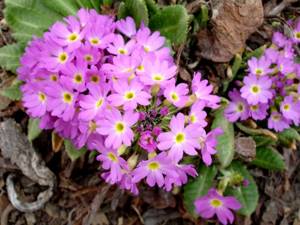
Primrose, primrose , is a perennial winter-hardy plant.
Primroses grow well and bloom profusely in spring in semi-shaded places on well-fertilized, sufficiently moist soil. When grown in one place for many years, it is necessary to add nutritious soil to the base of the bush to protect the primrose from freezing. Primroses reproduce by seeds and by dividing bushes.
Daylily is another favorite plant for the lazy gardener. Daylily is also called daylily, because each of its flowers lives only for a day. The plant is unpretentious, but prefers fertile and sufficiently moist soils; it grows in both sun and partial shade. Propagated by dividing the bush.
Mantle, alchemilla , is an interesting perennial plant. Unpretentious, winter-hardy. It can grow both in open places and in the shade. Soft cuff is grown in the garden. She prefers light, fertile, sufficiently moist soils. It blooms with small, inconspicuous yellow-green flowers. Very good for the foreground in a flower border - it has a beautifully shaped bush. Its most important property is that it “knows how” to push excess moisture out of the leaves. This is a truly magical sight - the cuff along the edge of the sheet is entirely decorated with a necklace of large transparent beads.
Sedum, sedum , is an unpretentious perennial plant. Grows well in any soil except wet, marshy soils. Prefers open sunny places. Propagated by dividing bushes and cuttings from stems.
Phlox subulate is a creeping perennial. The flowers are small, numerous, white, pink, blue or purple in color, completely covering the shoots so that no leaves are visible during the flowering period. Phlox subulate propagates by cuttings. An ideal plant for rocky gardens. Although phlox is subulate and winter-hardy, it is still better to cover it with a light covering material for the winter.
Cheremsha
With a garlicky flavor and plenty of vitamin C, this herb grows best in the shade of trees. It does not require care, but to obtain lush greenery, wild garlic needs to be provided with loose and non-acidic soil with a sufficient amount of organic matter. And keep in mind: the plant does not tolerate stagnant water, although it loves moist soil.
There is no need to create a separate bed for wild garlic. Just plant it under deciduous trees or shrubs, for example, near watering taps.
The plant is propagated both by seeds (they are sown before winter or in winter for seedlings in peat pots) and by bulbs (in autumn).
Better varieties of wild garlic: Bear cub, Bear delicacy, Bear ear.
| Planting depth | Sowing/planting scheme | The best predecessors | Good neighbors | Unwanted neighbors | Top dressing |
| 7-15 cm (for bulbs), 0.5-1 cm (for seeds) | 20×40 cm | Green manure, nightshade, pumpkin, cabbage, peas, beans | Hosta, Pushkinia, lily of the valley | Nettle, wheatgrass | Mulching with rotted organic matter |
Summer flowers
Day-lily
This is a tall plant that can bloom all summer. Daylilies come in a variety of colors ranging from white and pink to blue.
Phlox paniculata
These perennial garden flowers are distinguished by their fragrant scent and a large number of colors.
Lily
This capricious plant requires special care, but if you manage to choose the optimal care, lilies will delight you with their blooms almost all summer.
Chives
The thin pipe-like leaves of this onion are ideal for fresh salads and are an aromatic seasoning for soups, meat, fish and vegetable dishes. Chives are also good in landscape design: for 2-3 weeks they bloom with white, pink or pale purple tassel heads. This type of onion grows in one place for 5-6 years, then its clumps are divided (at the end of summer) and planted in a new place.
The best varieties for growing in the middle zone: Bohemia, Grass, Green Ray, Karat, Crocus, Honey plant, Prague, Chamal, Elvi.
| Sowing depth | Sowing/planting scheme | The best predecessors | Good neighbors | Unwanted neighbors | Top dressing (per 1 sq.m.) |
| 5-7 cm | 25-30×50-60 | Greens, legumes, cabbage, potatoes, cucumber, radish, tomato | Kohlrabi, broccoli, Brussels sprouts, beets, carrots, tomato, eggplant, lettuce, chicory, leek, garlic, strawberries, tobacco, cucumber, calendula, savory | Radish, radish, beans, peas, sage, white cabbage | In mid-spring - early summer - 1.5 tbsp. nitrophoska; in August - 2 tbsp. superphosphate, 1.5 tbsp. potassium sulfate |
Features of perennials
Compared to other plants, perennials adapt more easily to various changes in climate and environment. The reason for this is that they have a very developed root system that penetrates much deeper into the soil, which helps plants more easily obtain nutrients from the soil and groundwater. For the same reason, these plants tolerate strong temperature changes more easily.
When creating a garden interior, we must remember that garden perennials are the basis of any design, on which all other plants are superimposed.
Herbaceous garden perennials
host
Of course, the favorites in garden plots are herbaceous plants. Most of them are universal for use in landscape design. They look very good and beautiful both in combination with various flowers and decorative bushes, and alone. Accurate and correct selection of plants according to flowering time and colors, combined with the right choice of planting site, will make it possible to obtain continuous flowering from the beginning of spring until the first autumn frosts.
Heuchera and hosta are very good ornamental herbaceous plants because of their attractive openwork and large foliage.
The color and shape of perennials is very diverse. Mostly perennial plants are shade-loving, but with proper care they can delight owners with their beauty and freshness even in the scorching sun.
Most of them are frost-resistant, but some have to be dug up and stored in a cool, dry place. These are plants such as cannas, gladioli, nasturtiums, dahlias, etc.
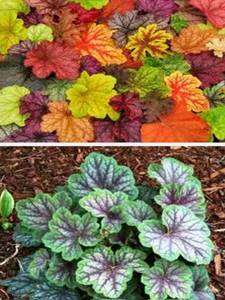
Heuchera
Moreover, the ideal temperature for preserving bulbs and rhizomes is 5 C. They need to be inspected periodically. Delicate tulips, fragrant lilies, fluffy asters, beautiful lupins, delightful irises, etc. can be left in the ground for the winter.
| garden lily of the valley | mullein |
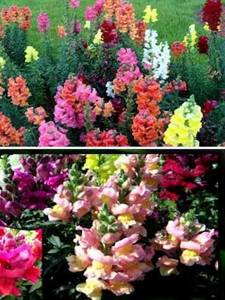
Snapdragon
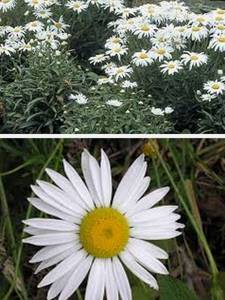
cornflower
The most used and common perennial flowers
Snapdragon. The height can reach one meter. Has a wide variety of flowering.
Mullein. The height reaches 2 meters. It is a bush with an abundance of yellow flowers up to 2 cm in diameter.
Nivyanyk. Plant height – no higher than 90 cm. Flowers of double structure.

sedum

Carpathian bell
Sedum. Height – from 10 to 25 cm. The shape of the flower resembles a star. Read how to grow sedum here.
Carpathian bell. The height of the flower is within 20-30 cm. These flowers bloom until the month of August.
Cornflower. The height reaches 90 cm. It is a very good honey plant. Pink flowers bloom twice a year.

cornflower
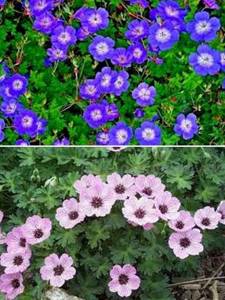
geranium
Geranium. The height of the flower is up to 60 cm. The colors of the flowers are very diverse - red, blue, purple, etc.
Lily of the valley. Height – up to 30 cm. Blooms with white fragrant flowers in spring.
Perennial flowers are great for creating long-blooming flower beds.
climbing plants
Climbing plants are very popular for use in vertical gardening of facades of houses, buildings, arches, hedges, etc. The most popular types of such plants: wisteria, Amur and wild grapes, ivy, climbing rose, blood-red Erica, etc.

ivy

climbing rose
Perennial plants are very diverse in flowering time, shape and color. With the help of such an abundance of plants, you can create unique compositions and fabulous landscapes at any country house or in your local area.
Perennial flowers are ideal for landscape design. Having planted them once, over the next few years you can enjoy their completely unique flowering.
And then read about growing perennial vegetable plants.
I invite you to the group for “Country Hobbies”
Spinach Uteusha
This spinach sorrel (sorrel) appeared relatively recently as a result of cross-pollination of Tien Shan sorrel with English spinach. The tall bushes are similar to horse sorrel, but taste like spinach. The hybrid was created by Ukrainian breeder Yuriy Uteush.
On this useful plant, leaves appear at the end of March; they are not afraid of returning spring frosts and autumn colds. Sow schawnat seeds in a sunny area in the fall - and from mid-April for 10-15 years you will be able to enjoy vitamin-rich greens. Seeds can be sown in spring, but then useful leaves can only be cut off in the next season. To keep the leaves juicy, the plant needs to be watered regularly.
Recommended varieties of spinach sorrel: Biekor-1, Kyiv ultra, Mentor.
| Sowing depth | Sowing/planting scheme | The best predecessors | Good neighbors | Unwanted neighbors | Top dressing (per 1 sq.m.) |
| 1.5-2.5 cm | 12-15×40-50 cm | Radish, radish, oats, potatoes, greens | Any plants | – | In the fall, add 2 tbsp. superphosphate and potassium sulfate |
Features of growing perennial flowers
Despite the simpler care than annual flowers, perennials have their own characteristics.
- Most perennial flowers are planted in the fall.
- Perennials are planted immediately in a permanent place, so that replanting is not required in the near future.
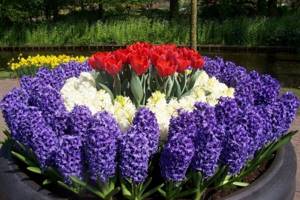
- Not all plants can overwinter in the ground. Bulbous perennials such as gladioli need to be dug up and kept warm.
- Perennial flowers for the garden are selected according to height. If the flowerbed is one-sided, then taller plants are placed in the background and shorter plants are placed on the apron so that they do not cover each other.
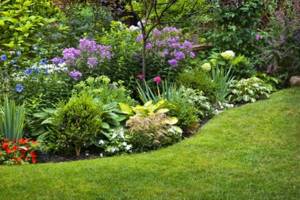
- Select flowers for your garden according to their flowering periods and color. It is not advisable to plant perennials of more than three colors in one flower garden.
- You can complement landscape design elements with perennial flowers, for example, rockeries or alpine slides.
In the video you will hear tips on growing perennial flowers for beginner gardeners.
Sorrel
Young sour sorrel leaves are good in salads, soups and even as a filling for pies. The leaf plate contains many useful acids - malic and citric. It is better not to eat old leaves, as they accumulate oxalic acid, which is not beneficial for the human body.
The plant thrives on fertile loams and does not tolerate alkaline soil. Seeds are sown in spring or early June. In the first year, it is better not to cut off the leaves, so that the next season the plant will form a large rosette.
- How to sow sorrel before winter
In order to reap a good harvest of sorrel next year, you can sow it before winter. Find out how to do it right.
The best varieties of sorrel: Vegetarian, High Mountain, Gringo, Green Fairy Tale, Emerald Snow, Chameleon, Shchi-borscht.
| Sowing depth | Sowing/planting scheme | The best predecessors | Good neighbors | Unwanted neighbors | Top dressing (per 1 sq.m.) |
| 1.5-2 cm (on light soils), 0.7-1 (on heavy soils) | 15×45 cm | Cabbage, lettuce, spinach, radishes, potatoes | Strawberries, carrots, radishes, cabbage | Tomato, pea, sage and other aromatic herbs | 1 tbsp. nitrophoska after each cutting |
Sage
Sage is a wonderfully versatile plant for your garden. It has many colorful varieties and growth habits. Try using it as a great filler for other tall garden plants. Sage will grow for many years and will return even in the harshest winter.
The only downside to growing sage over the years is that it can become woody, with leaves only growing at the end of the stem. Avoiding this means stimulating new growth. The leaves will grow closer to the cut, creating a more beautiful specimen.
The saint will eventually become a tree, which is inevitable. However, if you have more than one salvia, you can replace your woody plant with another salvia from your own landscape. It's as simple as cutting the roots and your old plant can sprout new roots.
Sage has a strong bitter taste and is commonly used in stuffings, stews, sausages and herbed breads. You will find that the little saint has come a long way in cooking.
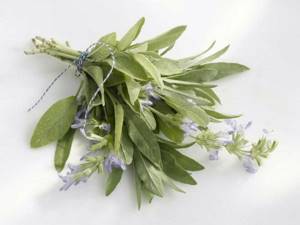
Sage.
It has many colorful varieties and the soft leaves come in many colors of green or dark green. It has a very attractive flower spike, so as a small bush, sage can be planted in the garden as an attractive succulent plant. It will grow in most climates, and if production drops severely, it will rebound the following spring. It can also be dried, dry herbs retain its strong aroma.
